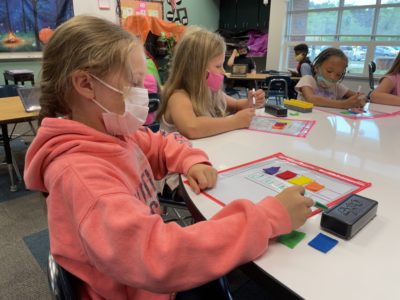
If you talked to a parent or educator in the past month, along with the enthusiasm for back to school, you probably heard about the shortages of teachers and staff our schools are facing. As kids came back to school in August, vacancies in North Carolina schools included 3,619 K-12 teachers; 1,342 bus drivers; 850 special education teachers; 354 counselors, social workers and psychologists; 70 assistant principals; 698 central office employees, and more than 4,362 other support staff, according to a survey by the N.C. School Superintendents Association. Not only that, there are over 3,000 certified teaching positions staffed by someone not fully licensed to teach in North Carolina.
One of my colleagues shared that her son and his 7th grade classmates don’t have a science teacher. Many 7th graders at his school also do not have a math teacher. This is in a large school district in the Triangle, at a school that has rarely dealt with major staffing shortages like those faced by some others in the state. This isn’t isolated to public schools. Many private schools share similar challenges. Every day our students go without being taught by a highly effective teacher is a day they miss critical learning opportunities to prepare them for their futures.
While North Carolina has reason to celebrate all the new high-tech jobs coming from corporations like Wolfspeed, VinFast, and Apple, we have to ask ourselves how they will fill these positions with qualified workers. What does it mean for our future workforce if kids in our schools now don’t have high-quality and well-prepared teachers?
It does not tell the full story to just point to the pandemic and the “great resignation” as the cause of the workforce challenges in our schools. This is a long brewing problem and can be at least partially attributed to policy decisions made over the past decade.
The facts:
- North Carolina per-pupil spending is at least $3,000 below the national annual average.
- Teachers in the state make $10,000 below the national average (and this includes the local supplements, which vary greatly from school district to district, so the state funding is much lower).
- Beginning teachers now make 17% less, and those with 35 years experience make 23% less, than their peers in Alabama.
- Our teachers received less than a 4% raise (including the step increases they were promised) — not even covering half of inflation for the same period.
The state has a generous budget surplus: $6.5 billion just this year. We have the money to turn the tide. Is there a better way to spend our surplus, will we get a better return, than to invest in our students?
I work daily with students, teachers, principals, superintendents, school board members, policymakers, and other state and local leaders. They struggle to reach long-term solutions to address recruiting and retaining a highly effective, diverse teacher workforce. While we must continue to improve teacher recruitment, retention, and diversity in the long-term, we cannot merely hope and wait for those interventions to come to fruition. We must do more now.
Here are five critical actions to take today:
- End the teacher pay penalty:
Raise base teacher pay by 24.5%. That is the difference when you compare teacher salaries to non-teacher college graduates, calculated by the Economic Policy Institute. We should address this immediately to support current and future teachers. For a beginning teacher, this would increase pay from $37,000 to $46,065. It would move the state from being in the bottom 10 to the top 20 states in terms of beginning teacher pay. It would make us No. 1 in the South and help to reduce the flow of teachers to other states, and ideally attract teachers to North Carolina. - Reinstate master’s pay for educators:
This would honor the advanced degrees earned by teachers and staff and reward professional growth, typical in other fields, states, and districts. Most school systems across the country recognize the value of advanced degrees with supplemental pay. Reinstating master’s pay would be a simple way to both strengthen the teaching profession and boost educator morale. - Create incentives for the most experienced teachers to stay in the classroom:
Florida has long had the Deferred Retirement Option Program, which allows teachers to declare that they are in the program upon retirement time, have their retirement benefits go into a trust that earns interest, continue to teach or work and receive their salary, and receive a lump sum from the trust upon retirement (typically five years after entering the program). This keeps many very effective educators in the field for longer. For educators and staff who have already retired, the limitations on returning to work in our public schools could be lifted to support schools and students. These individuals are typically certified and experienced. - Improve the A-F school grading scale:
Elected officials, regardless of party label, and education organizations say the formula for calculating A-F school grades must be changed. They recognize the importance of student growth as a larger part of the measurement. The current A-F school performance grades are more indicative of the percentage of students living in poverty than a measure of student learning. Revising the formula, for example to reflect 80% growth and 20% proficiency or even 50% growth and 50% proficiency, would be a simple and long overdue fix that would make a significant impact. - Eliminate PRAXIS Core as a requirement for teacher licensure:
While there is significant work going on through the State Board of Education and PEPSC to revamp the teacher licensure pathways, we can make some changes now. PRAXIS Core is a standardized test that does not correlate to teacher effectiveness. Yet it often keeps high-quality educators from entering the profession. We can eliminate this requirement now and reduce a barrier to entry without sacrificing our high standards for the teaching profession.
There is much to do to ensure that our state has a strong public education system, including implementing the steps in the Comprehensive Remedial Plan. It requires long-term, systemic investments and sustainable practices. The long-term efforts must continue, and these are some of the steps we must and can take now to begin providing a strong foundation for our state’s success and economy. It is a worthwhile and necessary endeavor.
Small increases in investment might have been a feasible solution years ago. But the magnitude of the widespread educator shortage and the resulting loss of learning opportunities commands big, bold action on behalf of our kids. While far from a comprehensive list of options, these are 5 steps we can – and must – take.
Our children simply cannot wait.
Recommended reading



